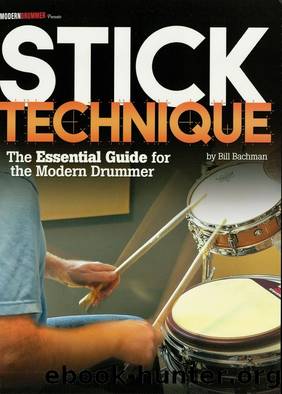Modern Drummer Presents Stick Technique (Music Instruction): The Essential Guide for the Modern Drummer by Bill Bachman

Author:Bill Bachman [Bachman, Bill]
Language: eng
Format: epub
Tags: music, Instruction & Study, General
ISBN: 9781476856537
Google: U5dMAgAAQBAJ
Publisher: Hal Leonard Corporation
Published: 2011-11-01T23:51:50.541746+00:00
PARADIDDLE
The paradiddle is one of the most frequently used rudiments, yet many players havenât tapped into its natural ability to develop accent and tap control. If you play paradiddles without a clear accent on the first beat, the rudiment can sound monotonous. But building your paradiddle chops using clear accentsâmade possible through downstroke/upstroke controlâwill allow you to play paradiddles and other compound stickings with more dynamic expression.
To begin, letâs look at the downstroke and upstroke techniques that are needed to play accented paradiddles. The downstroke starts high (roughly 90 degrees) but stops low after the stroke (around 1â from the head). The upstroke starts low and is lifted back to the âupâ position after striking the drum. The key to proper downstrokes is to hit the drum in the same way you would with a free strokeâbut immediately after the stick strikes the head, squeeze the stick into the palm in order to stop the stick pointing down with the stick tip close to the drum.
Assuming youâve developed the finger control necessary to play diddles, the biggest challenge with executing paradiddles is having to play a downstroke followed by a light diddle at a lower stick height. Playing on top of the sticks at a slightly higher angle relative to the drum will slightly reduce the accentâs rebound, which offers more leverage to stop the stick. (Remember that downstrokes point down.) Also, having the thumb on the topside of the stick, with no gap between the thumb and first finger, will make it much easier to squelch the stickâs rebound. Other than the downstroke accent, every other note in a paradiddle should be played with a loose grip where the sticks resonate freely and feel heavy in the hands.
At fast tempos, youâll want to employ the Moeller whip downstroke technique, which is is a modified downstroke where the stroke is played from the forearm with a whipping motion rather than from the wrist. (The wrist stays completely relaxed.) The Moeller whip downstroke is great for playing any rudiment that contains an accent and tap at faster tempos, since it alleviates the wristâs need to perform upstrokes. Youâll want to let some of the accentâs energy flow into the following diddle. Closing the fingers around the stick a little bit (without hitting the palm of the hand) will help get the stick back down to the drum so that they can play the diddle. At very fast tempos, the paradiddle will be played almost exclusively with forearms and fingers.
Here are technical guidelines for playing paradiddles at various tempos:
Slow: Stop the stick after the accent by squeezing the back of the stick against the palm. Use mainly wrist strokes for all notes.
Medium: Restrict the accentâs rebound with the fingers, but allow some of the stickâs energy to propel the unaccented notes. Use a combination of wrist and fingers for the inner beats.
Fast: Play accents using a slight Moeller whip stroke. Donât restrict the rebound after accents. Play unaccented inner beats with the fingers.
Download
This site does not store any files on its server. We only index and link to content provided by other sites. Please contact the content providers to delete copyright contents if any and email us, we'll remove relevant links or contents immediately.
Kathy Andrews Collection by Kathy Andrews(11688)
The remains of the day by Kazuo Ishiguro(8760)
Paper Towns by Green John(5030)
Spare by Prince Harry The Duke of Sussex(5004)
The Body: A Guide for Occupants by Bill Bryson(4893)
Industrial Automation from Scratch: A hands-on guide to using sensors, actuators, PLCs, HMIs, and SCADA to automate industrial processes by Olushola Akande(4855)
Machine Learning at Scale with H2O by Gregory Keys | David Whiting(3982)
Be in a Treehouse by Pete Nelson(3883)
Harry Potter and the Goblet Of Fire by J.K. Rowling(3746)
Never by Ken Follett(3715)
Goodbye Paradise(3672)
Into Thin Air by Jon Krakauer(3268)
The Remains of the Day by Kazuo Ishiguro(3261)
The Cellar by Natasha Preston(3225)
The Genius of Japanese Carpentry by Azby Brown(3199)
Fairy Tale by Stephen King(3163)
120 Days of Sodom by Marquis de Sade(3124)
Drawing Shortcuts: Developing Quick Drawing Skills Using Today's Technology by Leggitt Jim(2965)
The Man Who Died Twice by Richard Osman(2963)
